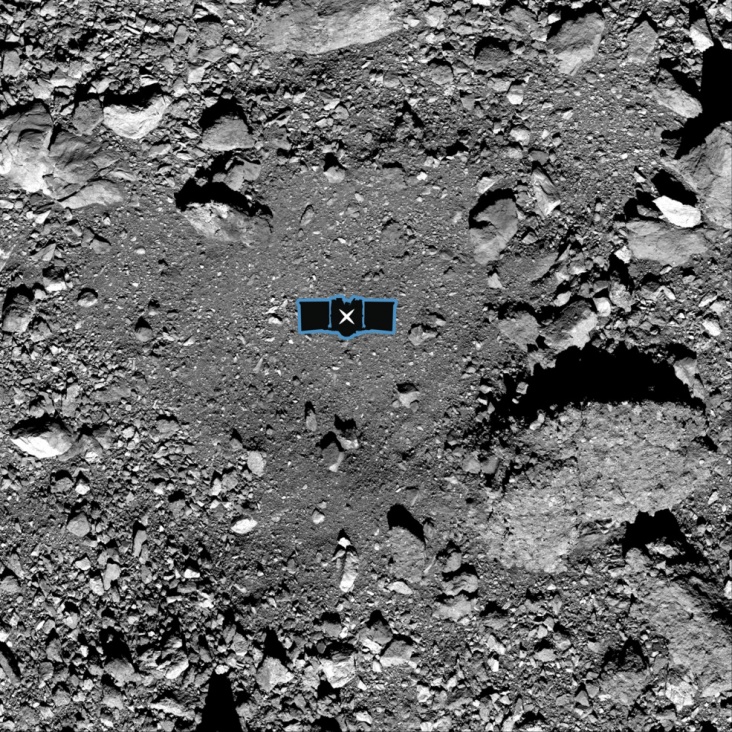Ruimtesonde vindt waterresten op planetoïde Bennu.

Credit: NASA/Goddard/University of Arizona
De NASA-ruimtesonde Osiris-Rex heeft sporen van water aangetroffen in een ruimterots op de planetoïde Bennu, waar het ruimtevoertuig sinds begin deze maand verkenningen uitvoert.
Het gaat niet om vloeibaar water, meldt NASA. De sporen zijn waarschijnlijk afkomstig van een grotere asteroïde waaraan Bennu vastzat.
De NASA-onderzoekers zijn blij met het nieuws. "We hebben de waterrijke mineralen uit de tijd van het ontstaan van het zonnestelsel ontdekt", zegt hoofdonderzoeker Dante Lauretta. "Dat zijn precies de sporen waarnaar we op zoek waren."
De vondst van water kan volgens de onderzoekers mogelijk meer vertellen over het ontstaan van het leven op aarde. "We willen echt graag weten wat de rol is geweest van dit soort planetoïden in de toevoer van water bij de totstandkoming van de aarde en hoe de aarde bewoonbaar is geworden", zegt Lauretta.
Ruim twee jaar
De ruimtesonde deed er ruim twee jaar over om de 2,2 miljoen kilometer naar Bennu af te leggen. In 2023 keert de Osiris-Rex terug naar aarde met stukken ruimterots.
Bennu ontstond 700 miljoen tot 2 miljard jaar geleden. De planetoïde draait in een baan om de zon die vergelijkbaar is met de baan van de aarde om de zon. Bennu staat nu wat dichter bij de aarde dan toen hij ontstond.
Bron: https://nos.nl/
WE HAVE ARRIVED!! (to asteroid Bennu) ???????????????? #OSIRISRex pic.twitter.com/XK5YfGUqCb
— ✍Leonardo D'Anchiano (@HdAnchiano) 3 december 2018
What’s next for #OsirisREx now that it arrived to the #asteroid, Bennu? ☄️ Sample collection and return await, but not without doing a few things first. Here’s everything YNTK ???????? pic.twitter.com/yEZRegVdh0
— Aerojet Rocketdyne (@AerojetRdyne) 4 december 2018
#OsirisRex space probe (Asteroid Sample Return Mission) has arrived at #Asteroid #Bennu! @OSIRISREx pic.twitter.com/TiQI30TZRl
— Jens Christian Heuer (@JChrHeuerSchach) 4 december 2018
NASA Mission Selects Final Four Site Candidates for Asteroid Sample Return

Pictured are the four candidate sample collection sites on asteroid Bennu selected by NASA’s OSIRIS-REx mission. Site Nightingale (top left) is located in Bennu’s northern hemisphere. Sites Kingfisher (top right) and Osprey (bottom left) are located in Bennu’s equatorial region. Site Sandpiper (bottom right) is located in Bennu’s southern hemisphere. In December, one of these sites will be chosen for the mission’s touchdown event.
Credits: NASA/University of ArizonaAfter months grappling with the rugged reality of asteroid Bennu’s surface, the team leading NASA’s first asteroid sample return mission has selected four potential sites for the Origins, Spectral Interpretation, Resource Identification, Security-Regolith Explorer (OSIRIS-REx) spacecraft to “tag” its cosmic dance partner.
Since its arrival in December 2018, the OSIRIS-REx spacecraft has mapped the entire asteroid in order to identify the safest and most accessible spots for the spacecraft to collect a sample. These four sites now will be studied in further detail in order to select the final two sites – a primary and backup – in December.
The team originally had planned to choose the final two sites by this point in the mission. Initial analysis of Earth-based observations suggested the asteroid’s surface likely contains large “ponds” of fine-grain material. The spacecraft’s earliest images, however, revealed Bennu has an especially rocky terrain. Since then, the asteroid’s boulder-filled topography has created a challenge for the team to identify safe areas containing sampleable material, which must be fine enough – less than 1 inch (2.5 cm) diameter – for the spacecraft’s sampling mechanism to ingest it.
“We knew that Bennu would surprise us, so we came prepared for whatever we might find,” said Dante Lauretta, OSIRIS-REx principal investigator at the University of Arizona, Tucson. “As with any mission of exploration, dealing with the unknown requires flexibility, resources and ingenuity. The OSIRIS-REx team has demonstrated these essential traits for overcoming the unexpected throughout the Bennu encounter.”
The original mission schedule intentionally included more than 300 days of extra time during asteroid operations to address such unexpected challenges. In a demonstration of its flexibility and ingenuity in response to Bennu’s surprises, the mission team is adapting its site selection process. Instead of down-selecting to the final two sites this summer, the mission will spend an additional four months studying the four candidate sites in detail, with a particular focus on identifying regions of fine-grain, sampleable material from upcoming, high-resolution observations of each site. The boulder maps that citizen science counters helped create through observations earlier this year were used as one of many pieces of data considered when assessing each site’s safety. The data collected will be key to selecting the final two sites best suited for sample collection.
In order to further adapt to Bennu’s ruggedness, the OSIRIS-REx team has made other adjustments to its sample site identification process. The original mission plan envisioned a sample site with a radius of 82 feet (25 m). Boulder-free sites of that size don’t exist on Bennu, so the team has instead identified sites ranging from 16 to 33 feet (5 to 10 m) in radius. In order for the spacecraft to accurately target a smaller site, the team reassessed the spacecraft’s operational capabilities to maximize its performance. The mission also has tightened its navigation requirements to guide the spacecraft to the asteroid’s surface, and developed a new sampling technique called “Bullseye TAG,” which uses images of the asteroid surface to navigate the spacecraft all the way to the actual surface with high accuracy. The mission’s performance so far has demonstrated the new standards are within its capabilities.
"Although OSIRIS-REx was designed to collect a sample from an asteroid with a beach-like area, the extraordinary in-flight performance to date demonstrates that we will be able to meet the challenge that the rugged surface of Bennu presents," said Rich Burns, OSIRIS-REx project manager at NASA’s Goddard Space Flight Center in Greenbelt, Maryland. "That extraordinary performance encompasses not only the spacecraft and instruments, but also the team who continues to meet every challenge that Bennu throws at us."
The four candidate sample sites on Bennu are designated Nightingale, Kingfisher, Osprey, and Sandpiper – all birds native to Egypt. The naming theme complements the mission’s two other naming conventions – Egyptian deities (the asteroid and spacecraft) and mythological birds (surface features on Bennu).
Since arriving at near-Earth asteroid Bennu in December 2018, NASA's OSIRIS-REx mission has been studying this small world of boulders, rocks, and loose rubble - and looking for a place to touch down. The goal of OSIRIS-REx is to collect a sample of Bennu in mid-2020, and return it to Earth in late 2023.
Credits: NASAThe four sites are diverse in both geographic location and geological features. While the amount of sampleable material in each site has yet to be determined, all four sites have been evaluated thoroughly to ensure the spacecraft’s safety as it descends to, touches and collects a sample from the asteroid’s surface.
Nightingale is the northern-most site, situated at 56 degrees north latitude on Bennu. There are multiple possible sampling regions in this site, which is set in a small crater encompassed by a larger crater 459 feet (140 m) in diameter. The site contains mostly fine-grain, dark material and has the lowest albedo, or reflection, and surface temperature of the four sites.
Kingfisher is located in a small crater near Bennu’s equator at 11 degrees north latitude. The crater has a diameter of 26 feet (8 m) and is surrounded by boulders, although the site itself is free of large rocks. Among the four sites, Kingfisher has the strongest spectral signature for hydrated minerals.
Osprey is set in a small crater, 66 feet (20 m) in diameter, which is also located in Bennu’s equatorial region at 11 degrees north latitude. There are several possible sampling regions within the site. The diversity of rock types in the surrounding area suggests that the regolith within Osprey may also be diverse. Osprey has the strongest spectral signature of carbon-rich material among the four sites.
Sandpiper is located in Bennu’s southern hemisphere, at 47 degrees south latitude. The site is in a relatively flat area on the wall of a large crater 207 ft (63 m) in diameter. Hydrated minerals are also present, which indicates that Sandpiper may contain unmodified water-rich material.
This fall, OSIRIS-REx will begin detailed analyses of the four candidate sites during the mission’s reconnaissance phase. During the first stage of this phase, the spacecraft will execute high passes over each of the four sites from a distance of 0.8 miles (1.29 km) to confirm they are safe and contain sampleable material. Closeup imaging also will map the features and landmarks required for the spacecraft’s autonomous navigation to the asteroid’s surface. The team will use the data from these passes to select the final primary and backup sample collection sites in December.
The second and third stages of reconnaissance will begin in early 2020 when the spacecraft will perform passes over the final two sites at lower altitudes and take even higher resolution observations of the surface to identify features, such as groupings of rocks that will be used to navigate to the surface for sample collection. OSIRIS-REx sample collection is scheduled for the latter half of 2020, and the spacecraft will return the asteroid samples to Earth on Sept. 24, 2023.
Goddard provides overall mission management, systems engineering, and safety and mission assurance for OSIRIS-REx. Dante Lauretta of the University of Arizona, Tucson, is the principal investigator, and the University of Arizona leads the science team and the mission’s science observation planning and data processing. Lockheed Martin Space in Denver built the spacecraft and is providing flight operations. Goddard and KinetX Aerospace are responsible for navigating the spacecraft. OSIRIS-REx is the third mission in NASA’s New Frontiers Program, which is managed by NASA’s Marshall Space Flight Center in Huntsville, Alabama, for the agency’s Science Mission Directorate in Washington.
Bron: nasa.gov
Nasa kiest een plek om planetoide Bennu te bemonsteren.
Hier gaat ruimtesonde OSIRIS-REx materiaal verzamelen om het vervolgens ook terug naar de aarde te brengen.Tot voor kort waren er nog vier mogelijke locaties voor bemonstering in de race, maar NASA heeft nu de knoop doorgehakt. Het wordt de Nightingale-krater. De krater bevindt zich op het noordelijk halfrond van Bennu en is ongeveer 140 meter breed.
Veiligheid voorop
OSIRIS-REx arriveerde een jaar geleden bij Bennu en cirkelt dus al geruime tijd rond de planetoïde. Eén van de belangrijkste doelstellingen in het eerste jaar na aankomst bij Bennu was het in kaart brengen van het oppervlak en het vinden van een geschikte plaats om dat oppervlak te bemonsteren. Zoals gezegd resulteerde dat eerder al in vier mogelijke locaties voor bemonstering. Alle vier de locaties hadden twee dingen gemeen: voor zover NASA het kon zien, konden er mooie monsters verzameld worden zonder dat OSIRIS-REx tijdens de afdaling naar het oppervlak en het bemonsteren ervan al te grote risico’s liep. In de afgelopen maanden zijn alle vier de locaties nog eens uitgebreid onderzocht en bleek Nightingale dus de beste optie te zijn. Hier is volgens NASA de grootste hoeveelheid fijnkorrelig (en dus gemakkelijk te verzamelen) materiaal te vinden. Bovendien is dat materiaal vrij gemakkelijk toegankelijk voor OSIRIS-REx en loopt de sonde tijdens het bemonsteren weinig risico’s. “Van de vier kandidaten voldoet Nightingale het best aan de gestelde criteria en is de kans op succes hier uiteindelijk het grootst,” aldus onderzoeker Dante Lauretta.
Spannend
Dat wil echter niet zeggen dat het een gelopen race is. Het afdalen richting een met keien en losliggend materiaal bedekt oppervlak is altijd spannend. Hoewel Nightingale een vrij grote krater is, is de plek waar de krater veilig bemonsterd kan worden met een diameter van 16 meter maar klein. Dat betekent dat de afdaling van OSIRIS-REx heel nauwkeurig zal moeten verlopen. Maar ook nadat OSIRIS-REx de monsters heeft verzameld, blijft het spannend. Want dan moet de sonde weer opstijgen. Wat dat betreft, kijken de onderzoekers met enige bezorgdheid naar de enorme kei op de oostelijke rand van de Nightingale-krater. Deze zou een gevaar kunnen vormen voor de sonde wanneer deze weer afstand neemt van de bemonsterde locatie.
TAGSAM
Om Bennu te bemonsteren, maakt OSIRIS-REx gebruik van de Touch and Go Sample Acquisition Mechanism (kortweg TAGSAM). Met het systeem kan losliggend materiaal op het oppervlak van de planetoïde worden verzameld
Mocht het om wat voor reden dan ook niet lukken om de Nightingale-krater te bemonsteren, dan is er een plan B. NASA heeft namelijk een reserve-locatie in gedachten, genaamd Osprey. Beide locaties worden vanaf januari nog eens door OSIRIS-REx onder de loep genomen. Het daadwerkelijke bemonsteren van één van deze locaties staat gepland voor augustus 2020, waarna OSIRIS-REx in 2021 afscheid neemt van Bennu en hopelijk met een buik vol oppervlaktemateriaal terugkeert naar de aarde. De monsters worden hier in september 2023 verwacht.

Hier zie je de Nightingale-krater. Om je een beeld te geven van de omvang ervan, heeft NASA OSIRIS-Rex ingetekend. De krater bevindt zich vrij noordelijk, waardoor de temperaturen hier lager liggen dan elders op de planetoïde en het oppervlaktemateriaal goed geconserveerd is. Wat ook voor deze locatie voor bemonstering pleit, is het feit dat de krater relatief jong is en het oppervlaktemateriaal dus nog niet zo lang blootligt. Onderzoekers hebben dan ook goede hoop dat ze hier een ongerept monster kunnen verzamelen dat meer inzicht geeft in de geschiedenis van Bennu en uiteindelijk ook in die van ons zonnestelsel. Afbeelding: NASA / Goddard / University of Arizona.
Bron: scientias.nl

 Ruimtesonde vindt waterresten op planetoïde Bennu
Ruimtesonde vindt waterresten op planetoïde Bennu




